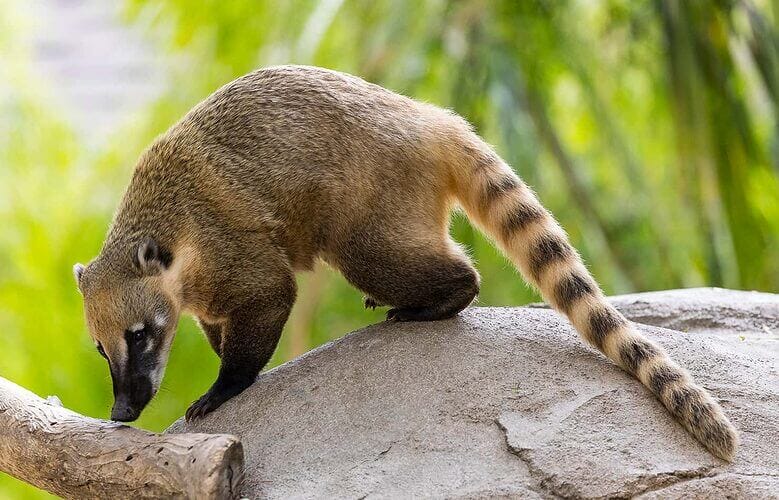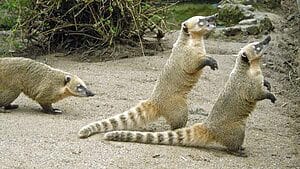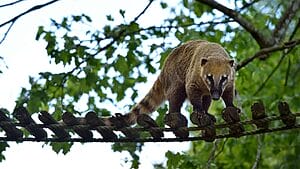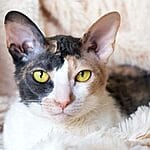Coati – Mammal Species 8 Facts In San Diego Zoo

What is Coati?
Is the Coatimundi the same as a Coati? Yes, the Coatimundi is the same as a Coati. Coatimundis are a type of raccoon that is native to Central and South America. They are medium-sized mammals that are active during the day and live in groups called bands. These animals are recognized for their long, slender snout, agility, and flexible bodies which enables them to climb trees and scale rocky terrain with ease.
The Coatimundi is an omnivore and feeds on a varied diet of fruits, insects, small mammals, and reptiles. These animals are typically kept as pets in some parts of the world due to their intelligence and curious personalities. Overall, both refer to the same animal with similar physical and behavioral characteristics.
What family do Coatis belong to?
Coatis are medium-sized mammals that belong to the family Procyonidae, which includes other animals like raccoons and kinkajous. Despite their similar appearance, they are not rodents, but rather belong to the genus Nasua. The most common species of coatis is the Nasua Nasua, also known as the South American coati or ring-tailed coati due to the ringed pattern of its tail.
Coatis have a slender body, long snout, and strong claws, making them excellent climbers in trees. They are also known for their social behavior, often living in large groups called bands, which can range from a few to over a hundred individuals. Overall, coatis are fascinating animals that play an important ecological role in their native habitats.

Is a coati a raccoon?
A coati is often mistaken for a raccoon, but both part of the raccoon family. They are raccoon cousins, classified under the Procyonidae family, which includes various species of South American and Central American mammals. Although they look similar, there are several differences between them in terms of behavior, size, and habitat.

Physical characteristics
Physical characteristics of coatis vary between male and female individuals. Adult males are typically larger and more robust than their female counterparts. Male coatis are alone and solitary creatures, while females and their young will stick together in groups.
Its physical appearance is unique, with their mammalian body shape and striped tails. A common nickname “hog-nosed raccoon” is due to their long snouts. It is covered in whiskers, aiding in their sense of touch while foraging for food. Coatis are also known for their brain size, which is relatively large compared to their body size. Overall, it make them interesting and unique creatures to observe in the wild.
Is a coati a carnivore, herbivore, or omnivore?
A coati is an omnivore, meaning it eats both plant and animal-based foods. Similar to a nocturnal raccoon, coatis will forage for food in the dark, often digging for insects or small animals to munch on. However, coatis also have a taste for fruits, roots, and seeds, making them opportunistic feeders. They have elongated snouts for digging, sharp teeth for hunting, and strong claws for climbing trees to grab food.
Coatis are known to travel in groups, and their diet can vary depending on the region they inhabit. In tropical areas, they may consume more fruits, while in drier areas, they may rely more on insects and small animals. Overall, the omnivorous nature of coatis allows them to adapt to different environments and survive in a variety of conditions.
Gestation period of coatimundis
The gestation period of coati is approximately 77-84 days. During the breeding season, adult males are solitary, except when breeding. Pregnant females will typically give birth to an average litter size of seven kits. After mating they will enter a period of gestation whereby they will carry the young coati for around three months. Once the time has come to an end, the female will give birth to her litter which will be cared for with the utmost dedication.
This breeding season typically lasts from December through to January, but can occur at any time of the year depending on the environmental conditions. The coati’s breeding season is a crucial time in which the developing kits must receive adequate nutrition to develop into healthy offspring.
Where do Coatis live?
They are found in Central and South America, typically living in dense forests, hills, and mountains. They prefer tropical and subtropical regions, where they can thrive in a diverse range of environments, including wetlands, grasslands, and forests. However, due to habitat loss and fragmentation, many populations of coati have become isolated and threatened.
Some individuals are now found in zoos and conservation centers, such as the San Diego Zoo Wildlife, where they can be studied and conserved. At the zoo, the animals are provided with habitats that mimic their natural habitats, ensuring that they can live healthily and happily. Overall, coatis are highly adaptable animals that can live in a wide range of environments, but their natural habitats are increasingly under threat.
Common species of Coatis
Depending on who you talk to, there are two to six different species of coatimundi.
The IUCN Red List has assessed four:
- The white-nosed coati (nasua narica, sometimes referred to as pizote), found from Arizona and New Mexico into northwest Colombia.
- The South American coati (nasua nasua, also known as the ring-tailed coati), found in north Argentina to Uruguay.
- The western mountain coati (nasuella olivacea) found in the Colombian and Ecuadorian Andes.
- The eastern mountain coati (nasuella meridensis), found in the Venezuelan Andes.
Here are some famous ones:
White-nosed coati
The white-nosed coati is the most well-known species. It is also known as the coatimundi, is a member of the raccoon family and is known for its long, thin snout with a white stripe on its nose. They are primarily found in the forests and wooded areas, from southern Mexico to northern Argentina.
They have a distinctive social structure, living in groups called bands or troops, which can number up to 30 individuals. White-nosed coatis are omnivorous, feeding on a variety of foods including fruits, insects, small animals, and bird eggs. They serve a vital role in their ecosystem by helping to disperse seeds and control insect populations.
South American coati:
The South American coati, also known as the ring-tailed coati, is a mammal native to Central and South America. They belong to the raccoon family and have a long and slender body with a pointed snout, small ears, and sharp claws. They are typically reddish-brown in color with a distinctive ringed tail that is longer than its body.
These carnivorous animals are active during the day and are usually found in groups of up to 30 individuals, known as bands, that are led by a dominant male. They are omnivorous and feed on a variety of food including fruits, insects, small animals, and carrion.
Mountain coati:
The mountain coati is another popular species, found in the Andes Mountains from Colombia down to Argentina. There are also other types of coatis, such as the western mountain coati, which is found in the mountains of Bolivia and Peru or the eastern mountain coati found in the Venezuelan Andes.
What is the lifespan of a Coati?
In the wild, coatis live up to 7 years. In human care, their average lifespan is 14 years, although they have been known to live into their late teens. In captivity, their average lifespan is about 10 years, although some coatis have been known to live into their late teens. Male coatis typically live solitary lives except during the breeding season.
Feeding habits – What do coatis eat?
Coatis eat fruit, invertebrates, small rodents and lizards. They look for food on the ground and sometimes in trees. Male coatis younger than two years of age and females, both related and unrelated, will group together in bands of four to 20 individuals. Bands made up of four to 20 individuals are formed by both related and unrelated to male as well as female coatis younger than two years of age.
Are coatis good pets?
Coatis are not recommended as pets as they are wild animals that belong in their natural habitat. While they may appear cute and friendly, they are still wild and have specific needs that can only be met in their natural environment. It is also important to consider their unpredictable behavior and their potential to carry diseases. In addition, in some areas it is illegal to keep coatis as pets without a proper permit.
It is always best to allow these animals to live in their natural habitat and appreciate them from a safe distance. If you are interested in coatis or other wild animals, it is better to visit them in accredited zoos or wildlife sanctuaries where they can be properly cared for and observed in their natural behavior.
What Are the Biggest Threats to the Coati?
Human Threats
One of the biggest threats to the coati is the illegal pet trade. These cute creatures are often victims of the illegal pet trade, as people want to keep them as pets. However, coatis are not meant to be domesticated animals and may become aggressive or suffer from health issues due to improper care.
Natural predators
In addition to human threats, coatis also face natural predators such as foxes and large birds of prey.
Population threats
Animals that have been kept as pets are never released into the wild, which reduces the overall population of the species. Habitat loss due to deforestation and other human activities also poses a significant threat to coati populations, as their natural habitats are destroyed. It is important to take steps to protect the coati and their natural habitats to ensure that this species is not lost forever.
Interesting Coatimundi Facts
- Coatis Are Named for Their Unique Noses
The indigenous South American Tupian languages are thought to be the source of the name coatimundi. The coati sleeps with its nose tucked into its belly, as indicated by the word “kua’ti,” which combines the words “cua,” which means “belt,” and “tim,” which means “nose.” With the help of these unique noses, they can detect termites and beetles as well as the occasional frog, lizard, or mouse.
2. Did you know that coatimundis communicate through a series of chirping sounds?
Females are much more social than males, who primarily use scent marking to establish territory among other males during the mating season. When their young are weaning, they whimper to communicate with them, and when danger is present, they bark more loudly to alert the rest of the band. The entire group will jump into trees and make clicking and woof-like noises when they are startled.
3. In Trees, They Give Birth.
Coatis are excellent climbers in addition to swimmers. They spend the majority of the day foraging for food on the ground, but they sleep, mate, and give birth in trees. After mating, the female starts the process of constructing a sturdy tree nest where she will give birth and spend the rest of her pregnancy.
She leaves the rest of the band behind and travels there by herself. The two to seven kits she gives birth to remain in the tree nest until they can climb on their own during the three-month gestation period. They re-join the group with their mother when they are between six and ten weeks old.
4. Coatis watch each other’s children
Coati kits are cared for in the isolated nests until they are about six weeks old and can rejoin their mother’s social group. Coati kits are able to stand on their own after 19 days and can climb at 26 days. The babies are guarded by the mother and the other female band members until they are weaned because it can take them up to 11 days for their eyes to open.
5. They are able to balance thanks to their tails.
Coatis, in contrast to some other arboreal mammals, cannot use their tails to grasp objects. Instead, the animals’ long, banded tails serve as balancing poles as they climb. The majority of the time, their powerful tails are held straight up as they forage on the ground. According to San Diego Zoo researchers, this behavior may aid them in keeping track of one another in the vegetation by acting as a flag to indicate their locations.
6. They Play an Important Role in Their Ecosystem
Much more is accomplished by all that foraging than just a coatimundi belly. Coatis are essential in regulating insect populations and aiding in the dispersal of seeds while consuming fruit, which is crucial for the survival of some plant species, according to studies on their role in the ecosystem. Coatis move dirt around while they forage, essentially aerating it with their long noses. The improved circulation makes it easier for the soil to absorb nutrients and water.
7. Their Ankles Are Double – Jointed.
Coatis have developed strong claws to dig out prey from logs and burrows as well as double-jointed ankles to aid in climbing trees.
Their double-jointed ankles can rotate a full 180 degrees, enabling them to descend trees headfirst with a fair amount of ease and speed, which makes it easier for them to elude predators. Additionally, these joints are very flexible. Due to their highly skilled front paws, they can easily escape from almost any human-made enclosure.
8. Coatis Are Experts in High Altitude
Coatimundis, regardless of species, are incredibly adaptable to a wide range of habitats, including those at extremely high altitudes. They have been spotted at elevations higher than 8,200 feet, and can be found in tropical areas, open forests, and the Andes Mountains.
Creator: PetsCareTip









